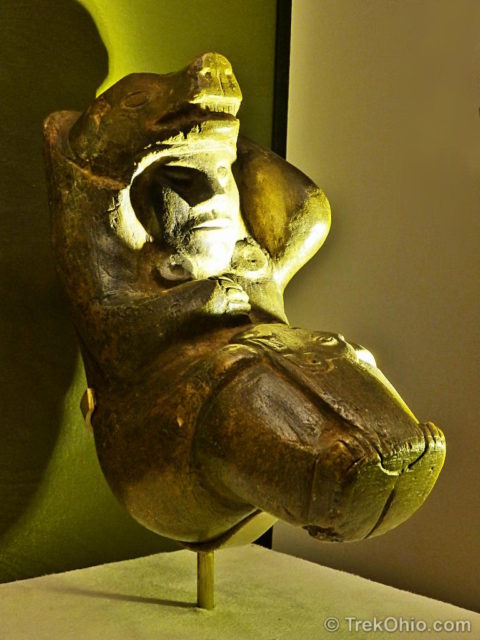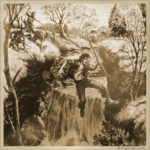When looking at the prehistoric artefacts and earthen structures in Ohio, I’m always wondering what meanings these things held for the people who created them. I end up reading whatever explanatory sign is posted nearby, but while I’m doing so I’m also wondering how anthropologists know any of this stuff. Since prehistoric societies don’t leave any texts explaining themselves or their culture, anthropologists have to be making a lot of inferences.

However when I was at Serpent Mound last year, I happened across a book in their gift shop that seemed to address many of my questions: Shamans of the Lost World: A Cognitive Approach to the Prehistoric Religion of the Ohio Hopewell by William F. Romain. The title caught my eye because it suggested that the book would explain the Hopewell religion to some degree, and it would also explain how the author arrived at his understanding of this religion. Since the focus of the book was the role of the shaman in Hopewell society, let’s start with shamans.
Shamans are said to live in shamanistic societies. Here is a brief outline of a typical shamanistic belief system.
- Everything has a spirit nature, whether it’s an animal, a rock, lightning, etc. This belief is an example of animism.
- The spirit that dwells within a creature or thing in the physical world is ruled over by a spirit lord that dwells in the spirit world. In other words, each class of earthly things (for instance, all deers) would have its own spirit lord (for example, the lord of all deer).
- Because everything has a spirit, everything that happens is intentional. If a tree falls on your cousin, it either wanted to fall on him, or was commanded to do so by its spirit lord.
- The shaman is able to travel between the physical world and the spirit world. The shaman conducts such travel to fulfill several functions.
- To gain information that will be useful in the physical world (for instance, to learn where a hunter should go to find deer).
- To request help or make bargains with a spirit (for instance, to placate an angry spirit that is making someone sick).
- To transport another person’s spirit to the spirit world (for instance, to show the soul of a deceased person the way to the spirit world). Someone who helps the deceased to journey to the next world is called a psychopomp.
- The shaman’s expertise on traveling between the physical world and spirit world also gives him the knowledge needed to build barriers that would prevent such travel (for instance, to keep the spirit of a dead person from re-entering the physical world as a ghost or zombie).
As an interesting aside, in animistic, hunter-gatherer societies, a hunter would typically believe that his prey either surrendered itself voluntarily to him, or it was commanded to sacrifice itself to him by its spirit lord. Consequently after killing the animal, the hunter would either offer his thanks to the specific animal’s spirit for its kindness, or to the spirit lord that sent the prey to him.
So that’s a brief description of shamanism in general. But how is it that anthropologists can assume that the Hopewell Indians held similar beliefs? It basically comes down to this. Societies holding shamanistic belief systems have been encountered all over the world, and these belief systems are strikingly similar to one another. Originally anthropologists thought that such a belief system must have originated in one place and over time must have been transmitted as people traveled from place to place. However, since shamanistic beliefs have been discovered in such widely dispersed places and over such a huge period of time, the direct-transmission theory has come to seem less and less credible.
The next explanation for such a widely held belief system was that shamanism reflected a way of thinking that emerged during altered states of consciousness, whether the altered state of consciousness arose due to mind-altering substances (such as peyote), physical stress (such as exhaustion, hunger, or thirst), or ritual practices (such as rhythmic chanting or movement). The author, Romain, rejects this explanation, but to my mind he didn’t really put forth a justification for his rejection.
Instead Romain turns to a field of study that first emerged at the end of the twentieth century, the cognitive science of religion. The premise for this field of study is that the human brain has a built-in tendency to religiously interpret both individual experience and wider phenomena. For instance cognitive scientists believe that the brain’s physiological functions include a causal operator that induces us to seek out an explanation for everything that happens. People would appear to have such a strong, built-in conviction that every action has a cause that people will infer an invisible cause when there isn’t one that’s apparent to the eye (for instance, gravity ![]() ).
).
However as social beings, our brains (specifically the frontal lobes of our brains) also perform a function called, perspective switching. Perspective switching allows us to put ourselves in another’s shoes. Once we’ve mentally changed places, we try to imagine what the other person’s motivations, desires and feelings are. By combining the human conviction that there are invisible causes with a predilection for perspective switching, people might very well end up projecting human motivations, desires, and feelings onto invisible causes and end up believing that invisible spirits dwell around them. And since both spirits and people are sentient, it probably seems possible for a person to enter into a relationship with a spirit… something that the shaman reports that he has experienced himself.
This is one possible explanation as to why shamanism is so widespread and why it is probably safe to assume that the Hopewell Indians were a shamanistic society whose beliefs mirrored those of similar societies. The author, Romain, elaborates on this further in his book. Besides this cognitive approach to anthropology, Romain also discusses ethnographic analogy, in which artifacts that have meaning in a known domain (for instance, those of Native Americans from the historic period) are compared to similar ones in an unknown domain (such as those of prehistoric Native Americans). He also discussed how anthropologists might infer deep timelines. For instance if you leave aside shamanism in its generalities and look at how it has expressed itself in a particular society, you might infer that the more widely dispersed a specific belief is, the further back in time the origin of that belief system goes. So if you found that there was a widely held belief among Indians of the historic period that there is in a mythological being of the underworld who looks like a panther, but who lives beneath the surface of the water, the fact that this belief is held over a wide geographical region might lead you to infer that the belief goes back a long way in time.
And now that we are in the Information Age, it turns out that there is something called the electronic Human Relations Area Files (eHRAF) Probability Sample database, that leads anthropologists such as Romain to say things like:
… of the sixty represented traditional cultures, a belief in ghosts was mentioned in the reports for forty-eight.
And from this an anthropologist might infer that a lesser known culture was likely to have believed in ghosts. He may then review that artifacts that have been uncovered from that culture to see if any of these support the hypothesis that a belief in ghosts was a part of their overall belief system.
More on Native American History



